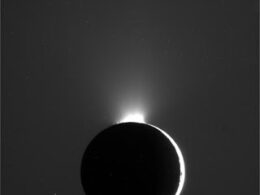A brilliant flash was observed this week in the atmosphere of giant planet Jupiter, believed to be due to an impacting asteroid.
The crash in the bands and belts encircling Jupiter was first reported by José Luis Pereira in Brazil. He caught it on CCD images recorded around 22h 39m UT on Tuesday 13 September 2021.
His image was processed and enhanced by Marc Delcroix, a French astronomer who runs a project to detect impact flashes on Jupiter. You can find out more about it here.
The impact, which showed as a flash considerably brighter than the brightest clouds on the planet, faded within a few moments. But it was confirmed by other amateur astronomers using CCD cameras to video Jupiter at the same time.
Jean-Paul Arnould, of the Société Lorraine d’Astronomie, in Nancy, France, recorded a series of images showing the impact flash brightening and fading, through a Celestron C11 telescope.
Simultaneously, the flash was captured from Langendorf, Germany, by Harald Paleske, using a 408 mm Newtonian telescope, as he watched Jupiter’s moon Io casting a shadow on the planet’s cloudtops. Harald told Skymania: “It was really one of the highlights of my planetary observing career. I was really excited!”
By 15 September, 7 people had discovered independently or captured the flash (1 from Brazil, 2 for Germany 3 from France 1 from Italy), Marc told Skymania. Subsequently, further independent observations of the flash have been confirmed. The other observers include Maciej Libert (Bremerhaven, Germany), Simone Galelli (Villachiara, Italy), Didier Walliang, Thibault Humbert, Stéphane Barré, and Alexis Desmougin (AstroQueyras, Saint-Véran observatory, France), Michel Jacquesson (Sévigny-Wallepe, France), Cosmin Sabdu Val (Romania), and Jean-Christophe Griveau (Mothern, France). Full details can be seen at Astrosurf.com.
Previous impacts on Jupiter
In July 1994, the author was observing with a 1-metre telescope at Puimichel, southern France, as fragments of a disintegrating comet, Shoemaker-Levy 9 collided with Jupiter, just beyond its visible limb, leaving a series of “bruises” in the clouds to rotate into view.
Those impacts had been long forecast because the orbit of the comet, under the effect of Jupiter’s gravitational pull, had been modelled well beforehand.
But since then, it has become clear that impacts on a smaller scale, but visible from Earth, happen more frequently than anyone might have imagined. The impacts show the importance of monitoring Jupiter for such events as a new field of observation for amateur astronomers.
Subsequent impacts
July 2009: Australian amateur Anthony Wesley was photographing Jupiter with his 14.5-in reflecting telescope at Murrumbateman, near Canberra, when he noticed a dark spot rotating into view in the planet’s south polar region. The NASA/ESA Hubble Space Telescope swung into action to take a detailed photo of the impact marking.
June 10, 2010: Anthony Wesley captured an impact flash live that was simultaneously photographed by another leading planetary imager, Christopher Go, of Cebu, in the Philippines. It showed as a bright spot on the illuminated region of Jupiter, but close to the terminator that divides day from night.
August 20, 2010: Just two months later, another cosmic impact was recorded on Jupiter by two Japanese astronomers. Masayuki Tachikawa, of Kumamoto city, recorded a photographed his images with a Philips Toucam Pro2 webcam attached to his telescope, a 150mm refractor. It was confirmed by another Japanese observer, Aoki Kazuo, who was also videoing the planet at the time.
September 9, 2012: American amateur astronomer Dan Petersen, of Racine, Wisconsin, observed a flash visually as he was viewing Jupiter with his 12-in Meade LX200 GPS telescope. The impact was confirmed by planetary observer George Hall, of Dallas, Texas, who was videoing Jupiter at the same time through an almost identical telescope.
March 17, 2016: Two amateur astronomers captured video records of a brilliant flash from an impact right on the edge of Jupiter’s visible disk. They were Gerrit Kernbauer, of Mödling, Austria, using a SkyWatcher 20cm (8-in) reflector, and John McKeon, of Dublin, Ireland, observing with an 11-in Schmidt-Cassegrain instrument.
May 26, 2017: A bright spot on Jupiter was first reported by amateur astronomer Sauveur Pedranghelu, who lives in Corsica, France, through his 203mm (8-in) Schmidt-Cassegrain telescope. It was later confirmed in images recorded by two German amateur astronomers, Andre Fleckstein, observing in infrared light, and Thomas Riessler.




